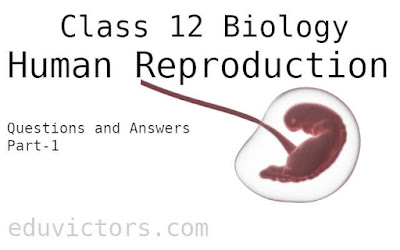Class 12 Biology - Human Reproduction (Questions and Answers) Part-1
Q1(NCERT). Fill in the blanks.
(a) Humans reproduce _____________________. (asexually/sexually)
(b) Humans are _____________________. (oviparous, viviparous, ovoviviparous)
(c) Fertilisation is _____________________ in humans. (external/internal)
(d) Male and female gametes are _____________________. (diploid/haploid)
(e) Zygote is _____________________. (diploid/haploid)
(f) The process of release of ovum from a mature follicle is called _____________________.
(g) Ovulation is induced by a hormone called _____________________.
(h) The fusion of male and female gametes is called _____________________.
(i) Fertilisation takes place in _____________________.
(j) Zygote divides to form _____________________ which is implanted in the uterus.
(k) The structure which provides a vascular connection between the foetus and uterus is called _______.
Answer:
(a) sexually, (b) viviparous,
(c) internal, (d) haploid,
(e) diploid, (f) ovulation,
(g) luteinising hormone,
(h) fertilisation,
(i) oviduct (ampullary–isthmic junction),
(j) blastocyst, (k) placenta.
Q2. Define human reproduction in a single line.
Answer: Human beings are sexually reproducing, viviparous organisms with internal fertilization and internal development.
Q3. What are the main reproductive events in human beings?
Answer: The reproductive events in human beings include:
➀ Gametogenesis
➁ Insemination
➂ Fertilisation
➃ Cleavage
➄ Implantation
➅ Establishment of placenta
➆ Embryonic development
➇ Development and growth of the foetus
➈ Parturition
➀ Gametogenesis
It is the formation of gametes through the process of meiosis inside the sex organs, that is, testis in males and ovaries in females. Gametes are called sperms in males and ova or egg in females.
➁ Insemination
It is the transfer of sperms from the male body into the genital tract of the female.
➂ Fertilisation
It is the fusion of male and female gametes to form a diploid cell called the zygote.
➃ Cleavage
The zygote undergoes cleavage that is mitotic divisions to first form a morula and then the blastocyst.
➄ Implantation
The blastocyst gets partially embedded in the walls of the uterus for attachment and nourishment.
➅ Establishment of placenta
A foetal-maternal connective called Placenta develops for attachment, nutrition, respiration and excretion of an embryo.
➆ Embryonic development
The implanted embryo undergoes gastrulation (Establishment of the three primary germ layers) and then organogenesis(Development of various tissues, organs and organ systems).
➇ Development and growth of the foetus
There is a growth of various parts and systems of the foetus so that they become fully functional. The foetus is then converted into a young one and the period of total stay of the embryo in the body of the mother is called the gestation period (Pregnancy).
➈ Parturition
The fully formed young one is delivered outside the mother’s body.
Q3. List the various characteristics of the human reproductive systems.
Answer: Various characteristics of the human reproductive systems
1) The sexes are separate and they show sexual dimorphism, that is, there is a difference in both the external features as well as the sex organs.
2) The stage when primary sex organs (Testes in males and ovaries in females which produce gametes and sex hormones) become functional is called puberty.
3) Full sexual maturity is attained slowly thereafter when accessory sex organs (Eg: Vas deferens, Epididymis, Prostate, seminal vesicles etc. in males and fallopian tubes, uterus, and vagina in females) develop and become functional.
4) Breeding can continue throughout the year, that is, humans are non-seasonal breeders.
5) Females remain reproductive from menarche (beginning of the first menstrual cycle) to menopause (stoppage of the Menstruation)
6) There is a common urinogenital duct in human males whereas the urinary and the genital ducts are separate in females.
7) Fertilisation is internal and occurs inside the body of the female in the fallopian tube.
8) The embryo develops inside the uterus of the female where it gets attached and nourished by the Placenta and this phenomenon is called vivipary.
9) Fully formed young ones are delivered by females and this phenomenon is called parturition.
10) Infants are fed on mother’s milk.
11) There is prolonged parental care.
Human Reproduction (Important Terms)
Human Reproduction System (Very Short Q & A)
HIV/AIDS (A Brief Introduction)
Human Reproduction (MCQs)
Reproductive Health (MCQs)



No comments:
Post a Comment
We love to hear your thoughts about this post!
Note: only a member of this blog may post a comment.